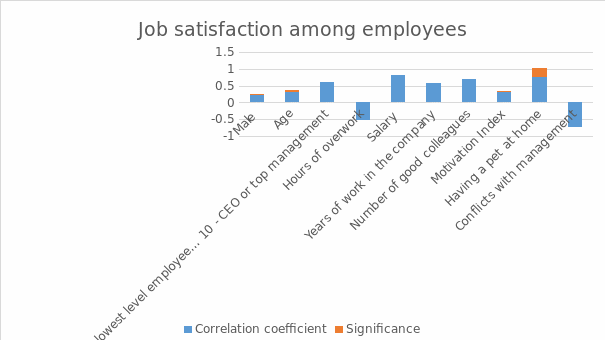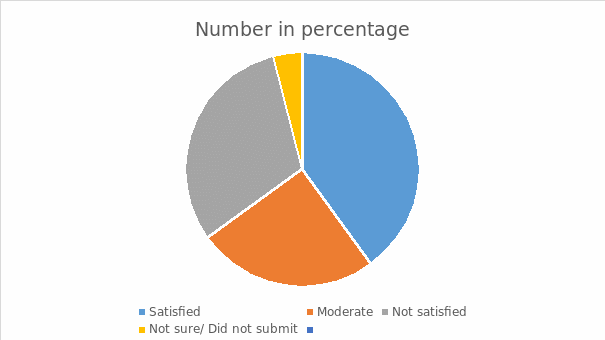Introduction
Work related stress could lead to poor performance, health, and welfare issues in employees. It is hence important to identify employees’ stress levels and create a conducive working environment for them. There are many factors that lead to work related stress. This paper comprises of primary and secondary research used to determine the stress levels in employees of our organization and factors that may lead to it. It highlights the findings of the research and gives recommendations for improvement.
Primary research
To identify the level of work stress in the organization, close-ended and self-administered questionnaires were developed and administered to all employees at Nescol Industries. Questionnaires were a better option for the survey as they ensured privacy of employees hence encourage expression. The following questionnaire was used;
Individual Questionnaire
Fill in the following questionnaire with a score of 1-10.
- It is impossible to impossible express my honest opinion in the at work ———-
- I have a lot of work responsibility but less decision making authority ——————-
- I can perform better with more time —————————-
- I rarely receive appreciation and acknowledgement for good performance ———–
- Generally, I do not like of my job ——————————————
- I feel discriminated against or constantly picked at work ——————————-
- I do not have a safe or pleasant working environment ———————————
- I have less time and attention for personal, family, and social obligations ————-
- I have frequent misunderstandings and arguments with my superiors at work ——-
- Add up the scores of each reply to have a Total Work Stress Score —————-
Secondary Research
To further understand workplace stress, an article by Health and Safety Executive (2009) was reviewed. The article clarified on the difference between work pressure and stress where by pressure could act as a catalyst to work harder. However, too much work pressure could result in stressful employees, thus should be avoided. Health and Safety Executive (HSE) advices employers and management to assess stressful situations at the work place regularly. In addition, they outline the benefits of reduced work stress such as increased productivity, saving money used to manage stress related complications, and raising a healthy workforce.
Workplace stress could be caused by several factors as noted by HSE. One of the primary factors include increased demand such as heavy workload, work patterns and unconducive working environment. Employees have indicated that they are unable to cope with heavy demands at work. Managers should ensure that the enforced systems cater for individual employee’s needs. HSE (2009) argue that employees who lack much control in their duties have stressful work environments. Such employees are not able to express their opinion on how to perform their duties best for increased production.
Lack of support from the management such as provision of necessary resources, sponsorship, and encouragement could motivate work related stress. Resources could be financial, information, or other resources required to perform a task HSE (2009). Colleagues and management relationships are important to establish a conducive working environment. Poor relationships and discrimination is a primary source of work stress among employees. HSE (2009) also notes that poor definition of employees’ roles could lead to conflict among employees and their superiors. Lastly, poor change management and communication in an organization would result in increased stress levels on employees.
Findings from Primary Research
After filling questionnaires, 96% of all the employees at Nescol Industries submitted them at the organization’s suggestion box. The company has 230 employees who all were considered as the sample size. The results from the analysis were as follows;
Findings from Secondary Research
The secondary source used in this research revealed the different sources of employees’ stress. It also revealed the factors that influence job satisfaction as shown below;
Correlations Analysis Results.
Conclusion
Without a doubt, a significant number of employees suffer from work-related stress. At Nescol Industries, 31% of the employees were identified to have stressful environments. The number is large enough to reveal that there is room for the management to improve working conditions. On the other hand, the secondary source reveal that employees are averagely satisfied with their jobs although different levels are driven by diverse factors. These factors include age, job position, workload, salary and conflict with management.
Recommendations
Vividly, the management of Nescol Industries need to close the gap between the satisfied and unsatisfied employees. To address this issue, several actions should be taken that meets needs at each employee’s level. To begin with, every employee should clearly understand their roles and responsibilities to avoid conflict with the management. Employees should be allowed to make basic decision on their line of work. A good communication channel and culture is also effective for reducing work stress. Encouraging and motivating employees while providing necessary resources is a primary method of motivating employees. Nescol Industries management should assess the amount of work done by every employee to employ more workers where needed. This will help to reduce work overload and overtime hours.
Reference List
Health and Safety Executive (2009). How to tackle work‐related stress: A guide for employers on making the management standards work. Web.
Appendices
Correlations Analysis Results.


